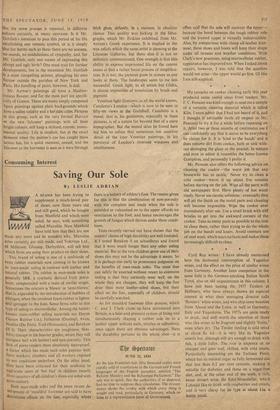Art
A Bomb Has Nine Lives
By SIMON HODGSON
him as a great 'every technical the latest pictures, spheres or ellipses rising sul- lenly into spacious backgrounds above energetic and explosive dark masses, one is aware of an exact feeling for size and shape, a rich but tightly controlled feeling for colour, an intense feeling for clarity and simplicity, which are, as Mr. Green- berg says, daring in conception and also devas- tating in their suddenness. What these symbols of brutish unease signify precisely is a more difficult question. The earth erupts and into the sky trundles a louring disc. Splendid! Strong stud, ut the same process is repeated, in different olours certainly, in many canvases. Is it Mr. ottlieb's intention to pass this period of his life tablishing one totemic symbol, or is it simply at for bursts such as these there are no seasons, o moods, no modulations of sympathy, and, for r. Gottlieb, only one means of expressing this abrupt and ugly birth? One must wait for further developments, but in the meantime Mr. Gottlieb is a most compelling painter, ploughing his own furrow outside the parishes of New York and aris. His handling of paint, however, is dull.
Mr. Ayrton's paintings all have a Mediter- ranean flavour, and for the most part are specifi- cally of Greece. There are many simply composed figure paintings against plain backgrounds which have a sullen solidity and a heraldic calm. Pictures in this group, such as the very formal Harvest or the two 'falconer' paintings, with all their bright colours, still keep a stylised, remote, monu- mental quality. Life is implicit, but at the exact Moment when the painter's eye has caught them action has, for a quick moment,. ceased, and the falconer or the harvester is seen as it were through thick glass, airlessly, in a vacuum, in absolute silence. This quality was lacking in the litho- graphs, which Mr. Erskine exhibited, from Mr. Ayrton's Greek experience. It is implied in the wax reliefs which the same artist is showing at the Leicester Galleries, but there also it is not so definitely communicated. One strength is that this ability to express imprisoned life on the canvas seems at first a rather banal process of simplifica- tion. It is not; the pictures grow in stature as one looks at them. The landscapes seem to me less successful. Greek light, to all artists but Ghika, is almost impossible of translation by brush and pigment.
Venetian light illumines, as all the world knows, Canaletto's London—Which is now to be seen in fifty-six views at the Guildhall. Canaletto is a mood; that is, his gentleness, especially in these pictures, is of a nature far beyond that of a mere topographer. But the muted skies he found here led him to soften that sometimes too assertive detail of the later Venetian paintings, in his portrayal of London's riverside windows and entablatures.







































 Previous page
Previous page